Japan[Niigata]Beyond ordinary itinerariesvol.10 Itoigawa Area in Niigata Prefecture
Itoigawa, the Ancient Jadestone Town, at the Edge of the Great Rift
2019.03.29
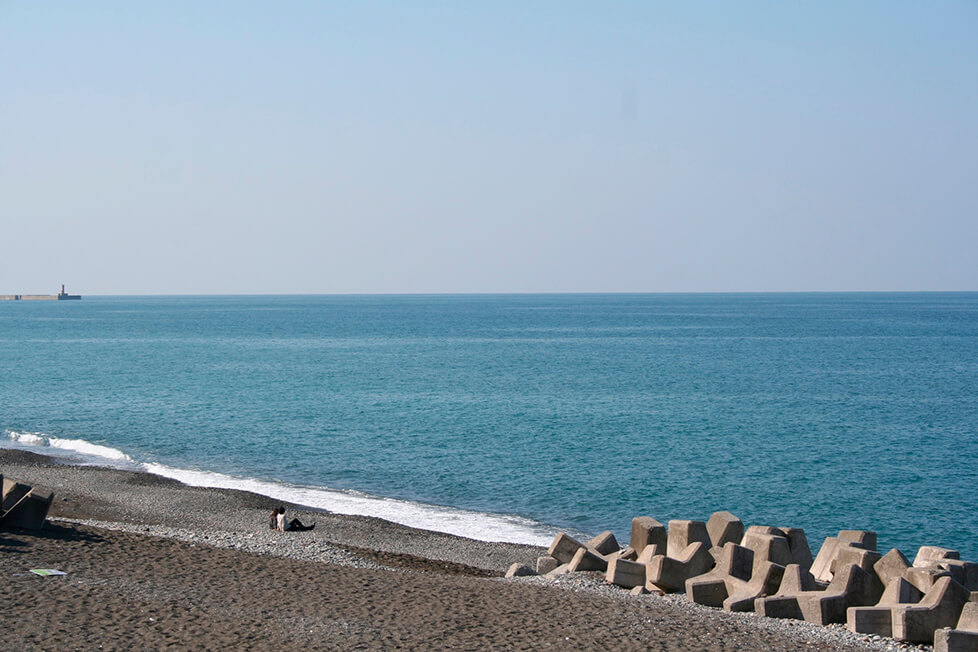
Itoigawa is located on the coast of the Sea of Japan in the westernmost parts of Niigata Prefecture. Itoigawa is said to be the place where jade culture first started in human history (not in Maya, Inca Empire or Ancient China). Over 5,000 years ago people in Itoigawa created necklaces and other jewelry from jadestones, which is considered to be the oldest jade culture in the world.
Those who are interested in samurai and the samurai spirit would be attracted to the ancient salt route from Itoigawa to the central part of Japan. During the 16th century, Uesugi Kenshin who ruled a vast area along the coast of the Sea of Japan sent salt to his opponent Takeda Shingen (who ruled the central part of Japan among the mountains) when another leading samurai, Imagawa Ujimasa (who ruled the area along the coast of the Pacific) stopped the supply of salt to Takeda. This salt is said to be from Itoigawa and brought through this ancient salt route, which is an origin of a Japanese famous proverb, “Sending salt to enemies”. It advocates for a sympathetic attitude toward enemies when they are in difficulty.
If you want to go to Itoigawa from Tokyo, take the Hokuriku Shinkansen “Hakutaka” bound for Kanazawa. In just a cozy two-hour trip, you will be in the ancient jadestone town, at the edge of the great rift.
The Jadestones of Itoigawa
Burying the Gap of 1,200 Years
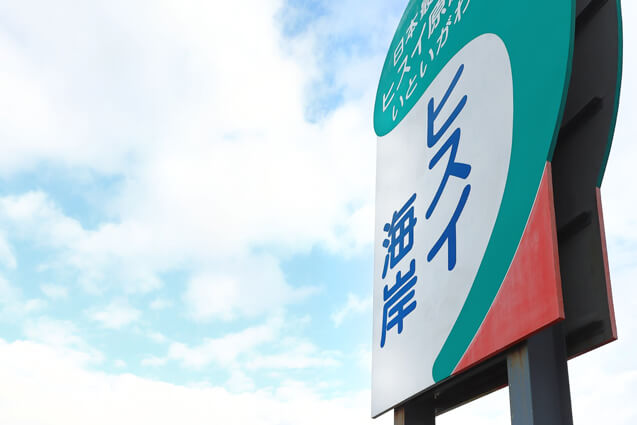
A poem in Manyoshu (the Collection of Ten Thousand Leaves), the oldest collection of Japanese poetry compiled during the 8th century, refers to Itoigawa’s jadestones. However, it had eluded common knowledge until 1939 when they were found on the bottom of the Kotaki River in Itoigawa.
Further research has been conducted and it was proved that all the Magatama jadestones excavated at prehistoric remains of tombs all over Japan were made in Itoigawa. After 1,200 years of time since the compilation of Manyoshu, the Itoigawa jade was rediscovered. In 1956 the area in Kotaki River where jadestones were found was given a new name, “Kotakigawa Jade Gorge”, and was designated as a National Natural Monument. In 2016 jade was chosen as the national stone of Japan.
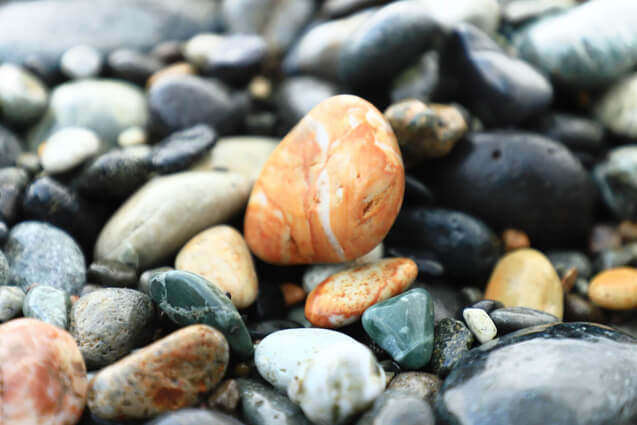
It is prohibited to pick jadestones in Kotakigawa Jade Gorge, but at beaches such as Hisui Kaigan (Jade Coast) and Oumi Kaigan (Blue Ocean Coast) anyone can become a jade hunter. If you bring your findings to the Fossa Magna Museum, you can get an appraisal by expert geologists!
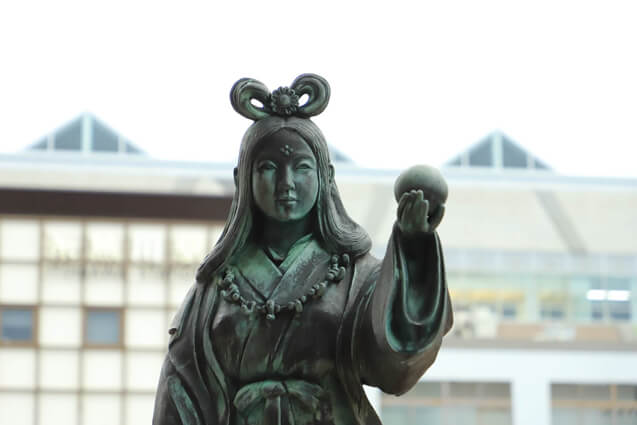
According to Kojiki (Records of Ancient Matters), the oldest extant chronicle of Japan, Princess Nunakawa was a goddess who ruled a vast area on the coast of the Sea of Japan. It is said the she was proposed to by Okuninushinomikoto, who is believed to be the “god” of nation-building and business, and the original ruler of Izumo Province.
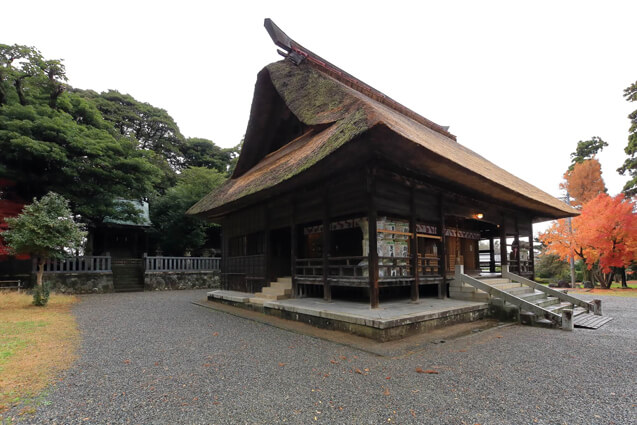
There are three small shrines dedicated to the worship of Princess Nunakawa, the Princess of Jade, including Amatsu Jinja here.
Amatsu Jinja (Amatsu Shrine)
1-3-34, Ichinomiya, Itoigawa-shi
Kotakigawa Hisui Kyo (Kotaki River Jade Gorge)
https://geo-itoigawa.com/igp/about/24geosite/geosite9/
Oaza Kotaki, Itoigawa-shi
☎ 025-553-1785(Itoigawa City Tourism Information Center)
Access: 40 min. by car from the Itoigawa Interchange of Hokuriku Expressway
1 hour by car from the Itoigawa Interchange of Hokuriku Expressway
* Not accessible during winter time from mid-November to mid-April due to piled snow.
Hisui Kaigan (Jade Coast)
2-4 Oshiage, Itoigawa-shi
☎ 025-552-1742 (Itoigawa City Tourism Bureau)
Access: 10 min. by car from the Itoigawa Interchange of Hokuriku Expressway
5 min. by car from the Itoigawa Station
Oumi Kaigan (Oumi Coast)
Suzawa, Itoigawa-shi
Access: 10 min. by car from the Itoigawa Interchange of Hokuriku Expressway
10 min. by car from the Itoigawa Station
Fossa Magna Museum
http://www.city.itoigawa.lg.jp/4586.htm
Stone Identification: from 10:00 a.m. to 12:00 p.m. / from 1:00 p.m. to 4:30 p.m. on Tuesdays, Thursdays, Saturdays, Sundays and bank holidays
The Buried Ancient Gap
Fossa Magna is one of the most famous Latin words that even primary school students know in Japan. If you know its meaning, your trip to Itoigawa will become more significant and enjoyable. Fossa means gap or rift, and magna is great or large.
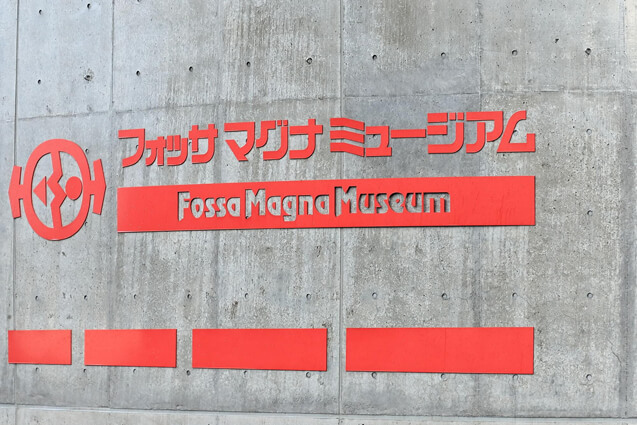
Approximately 20 million years ago, Japan had not been an archipelago but the southernmost coast of the Eurasian continent. It broke off from the continent 20 million to 12 million years ago. The western part rotated 40 to 50 degrees clockwise and the eastern part 40 to 50 degrees anti-clockwise. Simply speaking, the southern coastal line of the Eurasian continent was cut off, moved and folded down the middle. The large crack that developed there is the Fossa Magna. In the fossa, sea water remained for a while, but substances such as soil and volcanic ejecta piled up for a long time. It then upheaved due to the pressure and became the land as we know it. You may be able to imagine the sheer power of that pressure by thinking of how it transformed this deep gap into high mountain ranges including the Northern Japan Alps where Hakuba lies now.
The Fossa Magna Museum, a quite new museum founded in 1994, offers various exhibits about how the Japanese archipelago was created at the dawn of time including the mystery of the Fossa Magna with beautiful interactive displays. The collection of jadestones and fossils discovered in the area is magnificent.
Fossa Magna Museum
http://www.city.itoigawa.lg.jp/
1313, Oaza Ichinomiya, Itoigawa-shi (inside Miyama Park)
☎ 025-553-1880
Opening Hours: 9:00 a.m. to 5:00 p.m. (Entry is allowed up until 30 minutes before the museum closes.
Closing Day: Monday and the following day of bank holiday
(Seasonal variation: no closing day from March to November)
Admission: 500 yen (free of charge for children aged 18 years and under)
The Delights Brought by the Gap

Itoigawa is not only a place that gratifies your intellectual curiosity. It also stimulates your appetite! Being located at the coast of the Sea of Japan, Itoigawa offers delicious freshly caught seafood. However, many places near the sea do and their seafood is not worthy of special mention. But don’t forget about the Fossa Magna on whose edge Itoigawa is situated and that Itoigawa is the starting point of the Itoigawa-Shizuoka Tectonic Line which goes across the main island of Japan to Shizuoka Prefecture. There is a 1,000-meter-deep trench off the coast of Itoigawa. Thanks to this rift, a wide variety of fish can be caught nearby and fishermen don’t have to go far out to sea. In other words, fresh seafood is available in abundance. This enables us to savor various gifts from the sea, as fresh as possible, on a low budget. At Nou Gyoko (Nou Fishing Port) the auctions of fish start at three o’clock in the afternoon, which is very rare because normally fish auctions take place in early morning. Because of this afternoon auction, fish caught in the morning can be on the dinner table on the same day in Itoigawa.
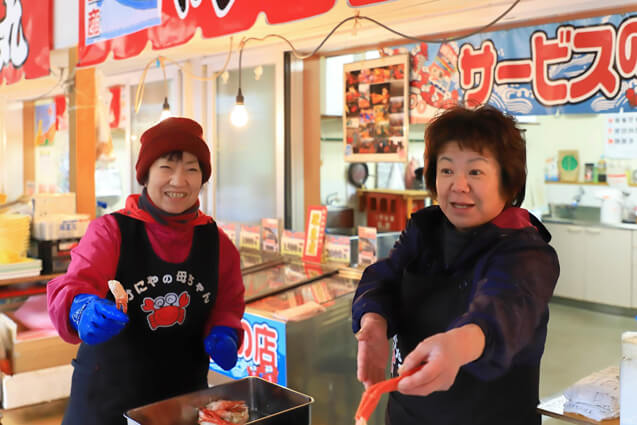
A fishermen’s market of beni-zuwaigani (red snow crabs) at Michi-no-eki (Road Station) Marine Dream Nou. The role of local fishermen’s wives is selling what their husbands catch in the sea and chatting with customers. If you try each shop’s boiled crab, you will taste the difference owed to each family’s secret preparation.
Joetsu Gyogyo Kyodo Kumiai Oroshiuri Ichiba
(Joetsu Fisheries Cooperative Association Wholesale Market)
7567-2 Nou, Itoigawa-shi
☎ 025-566-5155
Closing Day: Tuesdays and Saturdays (depending also on the weather)
Access: 7 min. by car from the Nou Interchange of Hokuriku Expressway
5 min. by car from Nou Station of Echigo Tokimeki Line
*Free entrance in the market for watching the auctions, but reservation is required for a guided tour.
Michi-no-eki Marine Dream Nou (Road Station Marine Dream Nou)
http://www.marine-dream.net/
3596-2 Nou Kodomari, Itoigawa-shi
☎ 025-566-3456
Opening Hours: 8:00 a.m. to 5:30 p.m. (Seasonal variation: 8:00 a.m. to 5:00 p.m. from November 1 to April 24)
Access: 5 min. by car from the Nou Interchange of Hokuriku Expressway
5 min. by car from Nou Station of Echigo Tokimeki Line
* During the closed season for crab fishing, January and February, locally caught benizuwai crab is not available. Other locally caught seafood remains available throughout the year.
The Shopping District that Overcame Tragedy
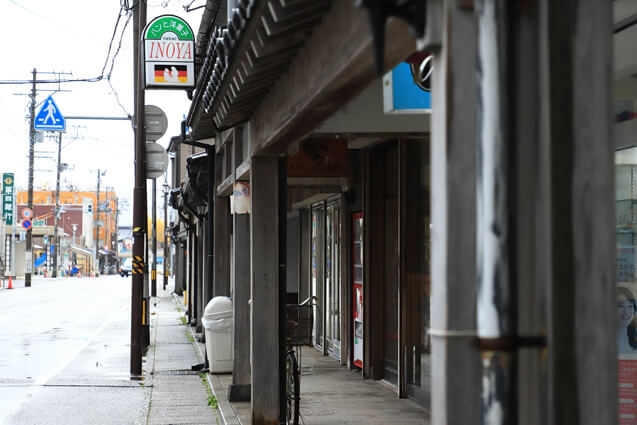
The area on the north side of Itoigawa Station towards the coast of the Sea of Japan is a shopping district with shops and restaurants. It had been an ordinary suburban shopping district until Christmas time in 2016. Many people in Japan still remember the incident reported in major news shows as catastrophic fires burned the district. Unluckily, it was a very windy day and the fire spread widely and it took almost 30 hours to be completely extinguished. At the beginning of 2019, about two years after the tragedy, smiles are coming back to the residents’ and shopkeepers’ faces, even though the whole district has not yet completely revived.
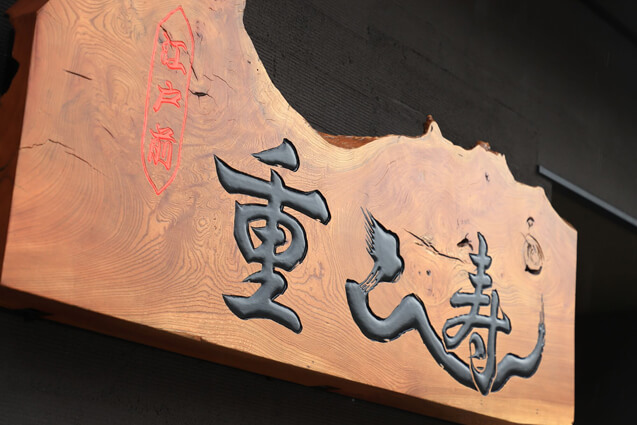
“Congratulations!” was the first word of a customer entering the restaurant. Shige-zushi is a sushi restaurant located on a back street of the main road called Hisui Road (Jade Road). Being very near to the source of the fire, the whole restaurant was burned down. For a year and a half Shige-zushi was in operation in a temporary location about 300 meters away to continue entertaining its regular customers. On November 1st, two years after the disaster, it was rebuilt in its original place, which the locals and visitors had been looking forward to.

Mr. Kiyoshi Tanimura, the third generation of the owner family. He operates the restaurant with his family and two cooks. The rice he uses for sushi is a blend of rice grown in Itoigawa and other places, the best blend that his father found. He maintains the family’s traditional taste. But he is not pompous at all saying, “I don’t like to get caught up in details. Everybody should just be honest with their preference!”
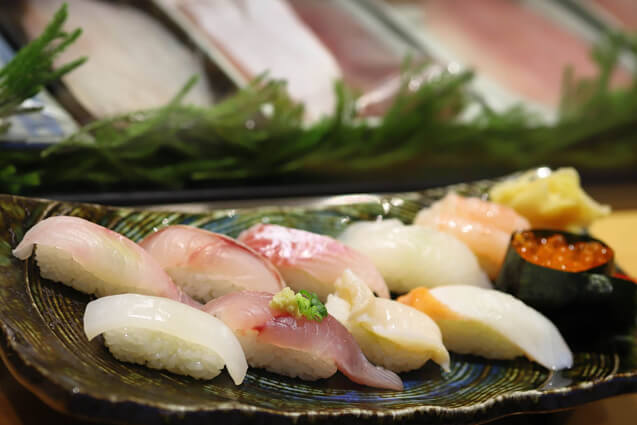
Scorpion fish, bigeye, rock-cod, John dory, sweet shrimp, etc… A set of sushi with locally caught fish. White-fleshed fish is very resilient and springy with a sweet aftertaste. Miso soup made from the stock of sweet shrimp is also unforgettable.
Shige-zushi
1-3-12 Omachi, Itoigawa-shi
☎ 025-552-0098
Opening Hours: 11:30 a.m. to 11:00 p.m.
Closing Day: Tuesday
Access: 4 min. walk from JR Itoigawa Station
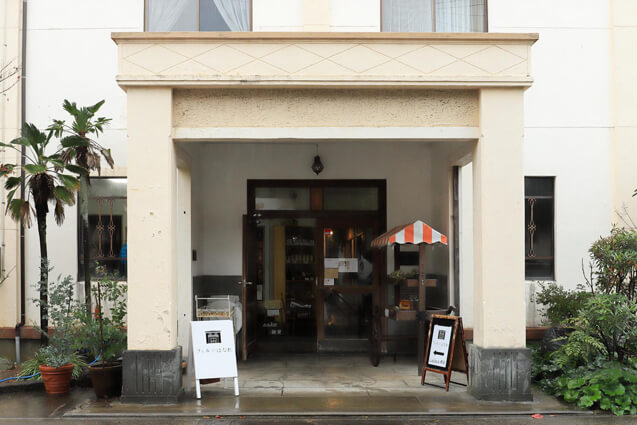
A retro-modern building at the corner of Omachi district was the first reinforced concrete building in Itoigawa, built in the 1920s, and as a result was registered as national tangible cultural property. It used to be the Takano Photo Studio but sat empty after the business moved into a larger location down the street. Luckily, it was undamaged during the fire of 2016. But this is not its first rodeo with fire. A fire in 1954 in the station area did not burn down this building either. Mr. Masaaki Takano, the owner of the building, decided to revive it as a significant place “after the tragedy” where the locals can gather to share a happy moment.
In 2017, a photo studio turned into a pastry shop. The pastry shop called “för ägg” run by Watanabe Poultry Farm opened a branch shop there. Pastries, puddings, and mayonnaise made from Watanabe’s fresh eggs developed especially for making pastries are available. But it is not just an ordinary pastry shop. The rooms serving as an oasis for the locals are also available. This shop symbolizes the power of connection between people as a cure for tragedy.

The old photo studio still remains preserved upstairs. Exploring a classic analogue photo studio is very interesting.
Feru no Hanare (För Annex)
https://f-agg.biz/
2-5-25 Omachi, Itoigawa-shi
☎ 025-555-7360
Opening Hours: 11:00 a.m. to 5:00 p.m.
(Seasonal variation: 11:00 a.m. to 4:00 p.m. from October to March)
Closing Day: Wednesdays and the fourth Thursday
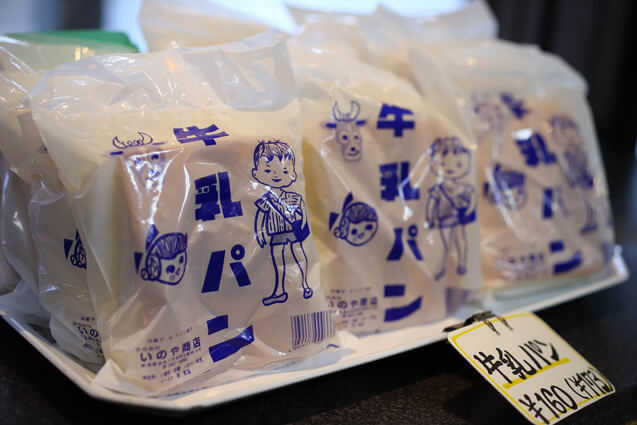
Their Gyunyu Pan (gyunyu is for milk and pan is for bread) is what is called the soul food of Itoigawa by the locals, but it is not a milk bread that you may imagine. One bite of this simple and fluffy sandwich makes you feel going back to the good old days.
Lieber Inoya, as its name suggests, is a bakery where also German bread and cakes are available. But its style looks very Japanese and maintains an atmosphere and the products of the good old days of Japan. In fact, its bread is affectionately called “soul food” by the locals. “My great grandfather started this bakery soon after World War II was over,” says Ms. Hisayo Inomata. She learned bread and cake making in Tokyo and came back to Itoigawa to succeed the family business. “It is not a big matter and we have carried the tradition for a long time,” continues Hisayo, but it may not have been that easy to keep the shop with its original products and concept through years full of changes.
When the fire was swallowing the shopping district, all the family members were busy with making Christmas cakes in the kitchen and no one had realized something terrible was happening outside until their neighbors came to tell them to escape. But they could not make a quick decision to leave the bakery that they loved. Three days later they were able to come back and found that there was no damage. Soon after the power lines were restored, they received so many telephone calls from people whom they don’t know including ones who live in distant places. This explains how much this bakery is loved by many people, not only by the locals.
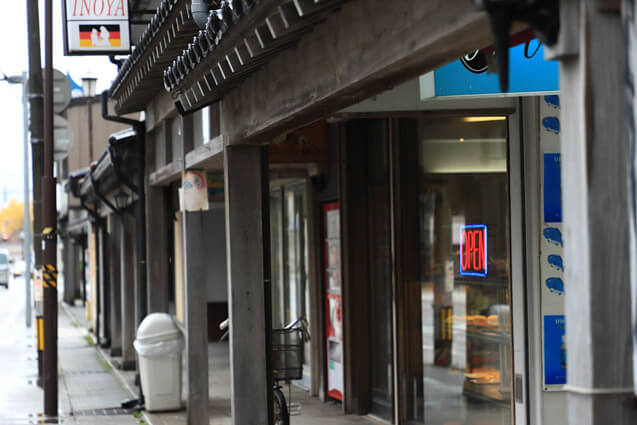
The sidewalks in the shopping district used to be covered with wooden roofs like an arcade. The roofing was made by extending the eaves. In Itoigawa, just like other places in the northern part of Japan, it snows heavily during winter time. People can walk and enjoy shopping without being disturbed by piled snow on the sidewalks thanks to the long eaves that owners of each house and shop made voluntarily. These eaves have a lovely name from their shape. They are called “Gangi” (“gan” is the word meaning wild geese, and “gi” is the word meaning wood) because the shape of the long eaves is said to look similar to flying wild geese.

“I’ve worked very hard seeking deliciousness and adventures. I will work even harder, returning to the starting point, in order to continue making one-of-a-kind bread. I’ll make bread and cakes that can bring joy to everybody.” This is the slogan written by Hisayo’s grandfather.
Lieber Inoya
6-8 Honcho, Itoigawa-shi
☎ 025-552-0260
Closing Days: Sunday
vol.10 Itoigawa Area in Niigata Prefecture
Itoigawa, the Ancient Jadestone Town, at the Edge of the Great Rift
(Itoigawa Area in Niigata Prefecture Booklet PDF)
(Itoigawa Area in Niigata Prefecture Booklet PDF [for printing])
This project is supported by the Kanto Bureau of Economy, Trade and Industry.









